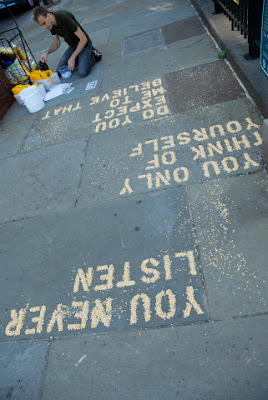
Environmentalism as we know it should die.
With that bold call, Ted Nordhaus and Michael Shellenberger riled many in the environmental movement in 2004 with when they presented their essay, "The Death of Environmentalism" [
pdf] at a conference of green funders. In it they argued that the tactics of traditional environmental groups are obsolete, especially in addressing a problem as grave as global warming, and that the very word "environment" sets us up to view nature as a thing to be defended from human incursion instead of an an element in a complex ecology of which we're part -- and which our lifestyles inevitably affect.
Further, they wrote, "today environmentalism is just another special interest," left to compete for legislative attention against activists lobbying around issues like labor, gender, race, and economic justice -- or, as they discovered first-hand, against each other. The founders of the
Apollo Alliance, Nordhaus and Shellenberger called for a new Apollo Project: an investment of $300 billion over 10 years to create three million clean-energy jobs and break America's dependence on oil. But when they set out to make their plea to Congress, they were approached by some of the big environmental groups.
"We were actually asked to withdraw the new Apollo project legislation by our environmental colleagues who were worried that it would get in the way of their efforts to kill the Bush energy bill," said Shellenberger in a phone interview last week. "Well, the Bush energy bill passed anyway; meanwhile we never made a big push for clean-energy investment."
On Tuesday night, Nordhaus and Shellenberger visit Minneapolis for a
Policy & a Pint discussion on their controversial new book
Break Through: From the Death of Environmentalism to the Politics of Possibility. 
It's a challenging read, unflinching in its criticism of liberal lobbying groups ("little more than an aggregation of the aggrieved"), beloved environmental icons like Al Gore and Edward Kennedy, Jr., and the environmental justice movement ("a category within a category, narrowly focusing on specific environmental issues issues and addressing neither the primary public health issues confronted by communities of color nor the central issues of economic opportunity, education, and social mobility that lie at the heart of poverty in America").
In last week's interview, Shellenberger discussed the book and how traditional environmentalism's narratives about regulation, sacrifice, and -- above all -- fear should be replaced by the "politics of possibility" -- and a massive investment in green technology that'll overhaul the entire global economy.
Paul Schmelzer: In the book, you state that America's environmental awakening in the late '60s is directly tied to affluence, and that only after our basic needs are met can we focus on “postmaterial” needs like natural habitats and air quality. Say more.
Michael Shellenberger: What you find universally is that, as people become more prosperous and they get their more basic material needs met, then they become more concerned about what social scientists sometimes call “quality of life concerns.” That explains a lot about when environmentalism was born in the United States.
We open the book by describing how everyone thinks the Cuyahoga River caught fire in 1969 for the first time and that everyone saw how polluted it was and then took action. The truth is, the Cuyahoga River had been catching on fire since the 1860s. In fact, most of the earlier fires were far worse. They killed people; there was massive amounts of damage. The river was actually in the process of being cleaned up by the late '60s. But the widespread attention to the 1969, as compared to earlier fires, is better explained by America’s newfound affluence. People were just much more concerned about those quality-of-life issues.
 PS:
PS: In the book you argue that a focus on jobs in the favelas of Rio de Janiero just might save the Amazon or that economic development might improve air quality in poor parts of America's cities. I fear we don’t have time to wait around for that.
MS: What we argue in the book is that until poor Chinese peasants or Brazilians living in poverty or even Americans living in Harlem can deal with more basic issues they confront -- such as joblessness or more basic challenges to their health -- they’re not going to be very concerned about issues like global warming or rainforest destruction. That’s not to say you shouldn’t worry about global warming and rainforest destruction, and it’s certainly not to suggest that we should wait to deal with those issues. That’s not an argument we make in the book. We argue instead that we need economic development both here in the United States and also in places like China and Brazil that is the kind of economic development that also helps us overcome ecological crises.
In the case of China, that means having a global strategy to bring down the price of clean energy as quickly as possible. That’s going to be a win-win if we do it right. The United States will obviously create a lot of jobs developing these new high technology clean energies. There’s one factory in China that creates one-quarter of the world’s solar panels. China is going to benefit enormously when we start really ramping up production of solar and wind.
PS: The metaphor of the Apollo Alliance, of course, is clear: the space race. To get free of petroleum, like getting a man on the moon, requires massive government investment.
MS: Every time America has faced big challenges like this, we’ve always overcome them by reinventing the economy. After the Civil War, the federal government created the railroads. During the New Deal, the government invested huge amounts of money in economic projects. World War II was essentially a huge manufacturing effort in the United States. After World War II, we built the interstate highway system, and we pay particular attention to the fact that in the late '50s and early '60s, the defense department guaranteed the market for microchips. It made very large contracts for microchips, and it literally brought down the price for microchips from $1,000 a chip to $20 a chip. And we also point out that the defense department invented the Internet, which later got commercialized. All of those efforts began with government investment, and when you look at the big sectors of the economy -- whether agriculture or transportation or aerospace -- they all rely on big government investments, so the idea that somehow that’s unusual requires a great bit of historical amnesia.
The point is that private-sector investors are not making the kind of investments and the size of investments that need to be made in order to bring down the price of solar panels so solar energy is as cheap as coal. That’s got to be the central goal for what we’re trying to do: make clean energy cheap. That’s the only way to quickly deal with global warming.
PS: The way you frame it in the book is interesting -- using an economic-prosperity model rather than a save-the-world framework. You'll get more buy-in when framing it through the "politics of possibility" than if you make environmentalism sound like taking vitamins.
MS: When I worked with big environmental groups, I had an epiphany on a phone call with an environmental attorney in Washington. I asked him, “Is it true what conservatives say, that if we try to do something about global warming it’ll wreck the economy?” He said, “Oh no, it’s just the opposite. What’s really going to happen is you’re going to get these big investments in new-energy technology, and that’s going to have a multiplier impact on the whole economy.” I kind of paused for a minute, and I said, well, why don't we talk about
that?
The interesting thing about when you cast this as a challenge of technology innovation, you don’t really have to believe in global warming in order to support it. You might support it because you want to get off foreign, imported oil, or you might support it because you recognize this as good for economic development, clean-energy markets being the fastest growing markets in the world. For us, technology innovation is what we need at a policy level, but it’s also something that has much wider appeal politically than more pollution regulations and more talk of global-warming disaster.
PS: What has the response been from conservatives?
MS: The book just came out, so we haven’t had much of a reaction from anybody yet. Conservatives understand the power of the market, and they understand the power of technology innovation, but most conservatives don’t understand the role of public investment, and they tend to see any government investment in the economy as causing more harm than good.
That’s just dogmatism. It’s a dogmatism that the younger generation of Republicans and the younger generation of conservatives really need to let go of. And I think there’s a lot of possibility here for that younger generation, which is disillusioned with president Bush, and the younger generation of progressives to find some common ground around a vision of major public investment in technology innovation.
PS: Some people, like James Howard Kunstler,
pooh-pooh the idea of relying on technology too much to solve our problems, as if it’s a silver bullet.
MS: It’s always funny to hear people that from people who live in the United States, whose very prosperous, comfortable lives are almost entirely dependent on the technology that was created by our grandparents and our great grandparents. There’s a kind of ingratitude among folks who are constantly talking about how terrible the world is and how horrible our lives are and how awful technology is.
Look, we’re living longer than any humans have ever lived. We have incredible medicines, we eat well, we’ve got better shelter than we’ve ever had... These are a bounty of wealth. We think Americans are going to feel much more capable of overcoming a big challenge like global warming when we start from acknowledging this incredible wealth.
We need a whole set of new technologies in order to make the world a more livable place and to roll back the tide of global warming. The idea that we’re somehow going to reduce our emissions in the United States by reducing our consumption by 80% is just fantasy. And frankly it’s a pretty scary fantasy at that.
 PS:
PS: In the book you criticize Al Gore for speaking "almost entirely of nightmares" in his film
An Inconvenient Truth, instead of offering "an inspiring vision of the future." This idea of recasting the narrative of environmentalism seems the emotional crux of your book.
MS: A lot of the stories that you hear about ecological crisis are really tragic narrative, so they often start by suggesting that humans at one point lived in harmony with nature and that humankind violated nature either through pollution or through science or through the Industrial Revolution, and that we’re now being punished for that by nature with ecological collapse. That’s a very old narrative: it’s the story of humankind’s fall from Eden in Genesis, and it probably goes back farther than that. In the book we point out that, really, humans have always been in a much more complicated relationship with their surroundings. Obviously we ourselves are part of nature. We evolved from the earth, and we never fell from it.
We believe there’s a more powerful story that should be told. It’s a story of a constant overcoming of adversity. If you look back, humans today are living longer, healthier lives. We have better medicine. We’ve overcome an enormous number of challenges: mass starvation and all sorts of ancient diseases. The history of humankind is not a story of our falling; if anything, it’s the story of our having risen. That’s a very powerful story to tell because it allows us to feel powerful and strong when thinking about new challenges such as global warming.
PS: And rethinking these narratives means--?
MS: Rethinking older conceptual frameworks. We talk about how we tend to think of global warming like an older pollution problem, or like a really big pollution problem. Dealing with acid rain meant attaching some scrubbers to smokestacks -- a very inexpensive fix. Dealing with smog in LA involved affixing catalytic converters to tailpipes. Well, dealing with global warming, there is no technical fix like that. You’ve got to literally go and replace coal and oil, and that is a massive undertaking. It’s really unprecedented.
We have in the past moved from whale oil to petroleum, and from wood and coal. But a strategy that’s really aimed at globally replacing these energy sources in a rapid period of time is really quite unprecedented, and it’s going to require something very different from the environmentalism we all grew up with.
For more on Break Through, read last week's discussions at Salon, Grist, and Talking Points Memo's book club.
 An essay I wrote on Kinji Akagawa for a publication in honor of his designation as 2007 McKnight Foundation Distinguished Artist.
An essay I wrote on Kinji Akagawa for a publication in honor of his designation as 2007 McKnight Foundation Distinguished Artist.















































